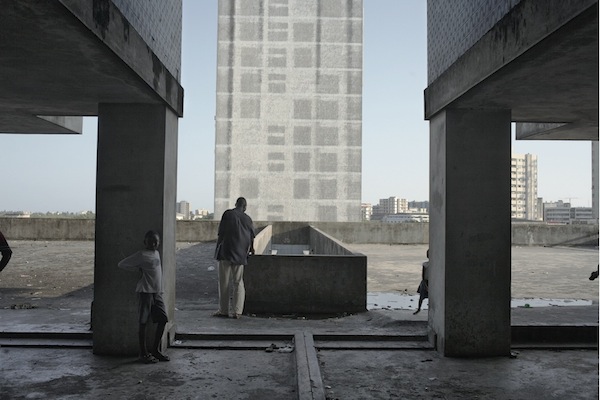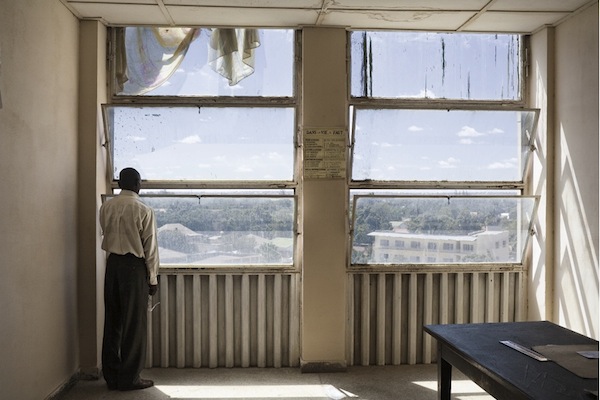
Guy Tillim: A Fantasy
Guy Tillim’s color photographs (2007-8) of quotidian African life in and around late-modern colonial buildings in cities of the Democratic Republic of the Congo, Madagascar, Angola, and Mozambique, point beyond a static condition of ruin and decay to the possibilities of creative improvisation and adaptation. The imposing foreign architectural language of Western rationalism has been softened by time, the elements, and human use, and yet lends a generous scale and order to the scenes. An unexpected synthesis, neither colonial nor indigenous, arises. “Life is always right!” replied Le Corbusier, when asked about the changes that inhabitants made to his buildings over time. People hang laundry everywhere, plant crops, sell chickens, walk home from school, work in offices, and seem to do a lot of contemplating. Yes, ideals were betrayed but much endures, including the statuesque forms of the worn-out buildings. A carefully handwritten poster in a city hall enumerates a barely remembered ethical code, broken into lists. “Avoid three things: laziness, vanity, shame. Control three things: character, language, conduct, etc…” Featured image: Guy Tillim, Apartment Building-Bagamoyo, 2007. Courtesy Lannan Foundation.
Guy Tillim’s engagement with a monument/ruin thematic is shared by artists Cyprien Gaillard and Sterling Ruby, among others today, who recognize the possibilities in apparent failure, entropy, or the breakdown that is a new beginning. This aesthetics of failure, an inheritance of romanticism, embraces imperfection, shards. It is interesting to consider Tillim in this company rather than in the photo-journalistic documentary tradition, which seems to lead discussion of his work. This shift in emphasis reminds us that the photograph is as much about the artist as the view. Tillim says “The impulse to photograph this stage is less an attempt to anchor the scenery than to situate myself.” As Cyprien Gaillard indicates, what matters is the “importance of confronting yourself in a landscape rather than accepting it as given.”
Tillim mentions the decade from roughly 1950 to 1960, when these buildings were erected, as a “strange contemporary mythological time.” It was then that Patrice Lumumba, the Congolese independence leader for whom this series of photographs is named, championed the ideals of national unity, economic independence, and pan-African solidarity that inspired hope for freedom and material prosperity. This dream, which threatened US interests, was brutally cut short with Lumumba’s 1960 assassination. Tillim’s photographs suggest an ongoing subjunctive mood of uncertainty in which time passes but the dream does not materialize as imagined. This anachronism, literally time out of order, has an odd appeal to an ever-accelerating western nostalgia. Our information age, dominated by the high-speed intangible workings of data, is understandably full of longing for a world of touchable, explicable things. Though some viewers might recoil from a decrepitude that is a universal threat, not merely African, the evident grandeur and repose displayed in Tillim’s images must lure most of them back.

Guy Tillim, City Hall, Lumumbashi. Courtesy Lannan Foundation.
Knowing our propensity to exoticize by staying on the surface, and leaving aside the photographer’s intentions, which surely include a claim on some kind of documentary “truth”, we might choose temporarily to give in to revery, and experience these photographs as a fantasy of the real. Tillim’s blanched photos depict a world without veneer, a world of structure, of bones, of sun-light and sun-shadow, where things seem to be what they seem, quite unlike the contemporary built world in the US.
In Tillim’s photographs, each object, and each person have their own singular space-time, pared and slowed down as if for a stage set, giving every appearance of belonging to an analog world. Cell phones are advertised and may rest on hips, but the pushbutton phone, typewriter, rubber stamp, file folder and pen reign in the somnolent office world depicted in 7 of the 19 photographs in the exhibition. Two men, one with his back to us, hatted, the other dangling eyeglasses, gaze contemplatively out of a steel casement office window. No harried clerks here. In another image, a man, whose family is just moving into a former bank building, stands between a wall of light and a gloriously hot pink talismanic towel with a golden key motif that is suspended on a line in the shadow. In a Lumumbashi city hall, a man sits at a desk wearing a t-shirt with a line drawing of a handshake, and writes; behind him a wire traipses lackadaisically down the wall. In the foreground a battery wire becomes entangled in vine that climbs up toward the shelves and a flat freestanding metal map of Africa. The whole image is a delicate, eloquent balancing act reminiscent of Klee’s walk with a line. In an office in Likasi, Congo, a woman writes on a desk with a hole larger than her paper. Her co-worker wearing an African geometric patterned dress whose hem reads “véritable,real” types on a mechanical machine below a Vodaphone poster declaring “One nation, one web”. Purpose is poised against the abyss, ancient against contemporary, real against real in mise en abîme fashion.
The Grande Hotel built as a luxury hotel in 1955 in Beira, has become squatter housing for a community of two to three thousand people. The illusory skin of luxury has given way, corn and other crops are cultivated, laundry hangs on every balcony, boys idle at the pool, but the vertiginous compositions suggest a post-apocalypse Hollywood set in which anything may happen.
Somehow contrary to what one might suppose, given the subdued dreamy atmosphere of Tillim’s series, he professes enthusiasm for the current ubiquity of digital media. In conversation with author Adam Hochschild at The Lensic Theatre, Tillim said that ours may be a golden age of sophistication about images, because everyone is a producer and interpreter of images. Tillim himself certainly is such a sophisticate, a veteran photojournalist who worked on assignment in the middle of the fray, now independent artist exhibiting in the strictures of the white cube (or in this case, the yellow corridors of Lannan Foundation). He composes thoughtfully, aware that in our digital era there is no line between document and fantasy, yet searching for his place within the unfolding we will later call history.
Guy Tillim: Avenue Patrice Lumumba is on view at Lannan Foundation on Saturdays and Sundays from 12 – 5 through September 4.
